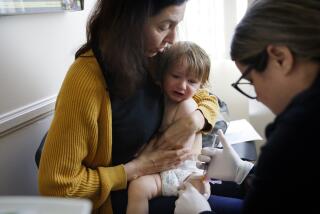Giving Full Immunization a Shot : Health: Mobile medical vans and free clinics are making it easier to reach children in low-income areas. The younger the better, officials say.
- Share via
Stone-faced 8-year-olds mentally prepare themselves. Infants in the background weep hopelessly while they’re cradled in a stranger’s arms.
Then a nurse produces a needle.
Showing off the bandage on the top of her left arm, 8-year-old Charde Tate shook her head confidently, affirming that she was ready for her vaccination shots minutes earlier. Charde and sisters Daniell, 10, and Charmaine, 5, recently received immunization shots from physicians assistants who visited South-Central’s Praises of Zion Baptist Church in mobile clinics.
“It made it more convenient for them to come here,” said their mother, Paula Tate. “I liked the whole idea of them coming to the community.”
After a measles epidemic swept Los Angeles County from 1987 to 1991, aggressive campaigns have been conducted to raise community awareness of the importance of immunizations against nine major preventable diseases. Before the epidemic, according to the county Department of Health Services, only 39% of preschool-age children had completed their immunizations by their second birthday. Now the figure is 58%.
But among African American and Latino children, especially those in low-income areas, the immunization rate remains lower than average.
“In our study the last couple of years, only 42% of Latino kids are up-to-date (with immunizations), and 25% of African American kids had all their shots by the time they were 2 years old,” said Dr. David Wood, a pediatrician and assistant professor of pediatrics at Cedars-Sinai Medical Center. “But they had seven to eight doctor visits a year for minor illnesses.”
Part of the problem, pediatricians say, is that poor citizens of all ethnicities often cannot afford to take time off work for trips to the doctor or public clinics where shots are offered for free. In addition, many illegal immigrants are wary of taking their children for immunization, fearing they will be identified.
Health officials are hoping to combat that trend by promoting joint efforts between county and private providers, and by developing a tracking system to determine who has been immunized in highly mobile populations.
For example, health department officials countywide are promoting the use of the Watts Health Foundation’s 12 mobile units and the 43 county health clinics, which some say are underused.
“We don’t care if the patient is legal, illegal, poor or rich--the shots are all free,” said Nina Vassilian, senior health educator for the Department of Health Services. “We don’t ask questions (of that nature).”
Eighteen shots are required for full immunization against diphtheria, tetanus, pertussis (whooping cough), polio, measles, mumps, rubella, Type B influenza and hepatitis B.
The county has had only isolated cases of measles, whooping cough and other highly infectious diseases in recent years. Nearly all children are fully vaccinated by the time they reach kindergarten because schools require the shots before children can be enrolled.
But pediatricians say parents must be made aware that earlier immunization is the safest course. By age 2, children should have received four DTP (diphtheria, tetanus, pertussis) shots, two oral polio vaccines and one MMR (measles, mumps, rubella) shot.
“Cost is not a factor,” said Paul Frederick, an epidemiologist with the immunization program at the Department of Health Services. “A big factor is education--instilling in the minds of people how important that immunization schedule is.
“From 1980 on up, we were hovering around the 40% to 50% range, and in 1990 we went up to 58%. We hope it’s not sporadic,” Frederick said. “By the year 2000 we want to make sure that we have that 30% increase.”
From mobile health clinics to computerized tracking systems, health experts are trying to reach every corner of the city. Wood said a universal tracking system should be ready in five years.
The system, a computerized registry that will keep tabs on shots for all preschool children in the county, will be installed in five city health clinics by the end of the year. Wood will head the system funded by grants from the federal Centers for Disease Control and Prevention.
Although some populations are highly mobile, many institutions remain constants in their lives. By tapping into those sources, health officials say, tracking and education can be made easier.
During the tail end of the measles epidemic, for instance, Vassilian started working closely with the Catholic Church, which has a high Latino following, to persuade parishioners to vaccinate their children before baptism.
But even with the support of Cardinal Roger M. Mahony, it has been difficult to implement the project because of a low level of collaboration by individual churches. The health department has only been able to monitor 100 babies since 1992.
The California Immunization Baby Track has been more successful, Vassilian said. The program targets maternity hospitals in the county and works with volunteers who visit the mothers.
Information on immunizations: (800) 427-8700.
More to Read
Sign up for Essential California
The most important California stories and recommendations in your inbox every morning.
You may occasionally receive promotional content from the Los Angeles Times.













